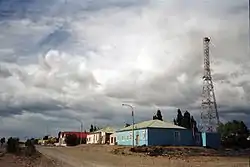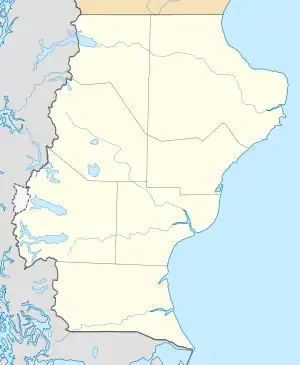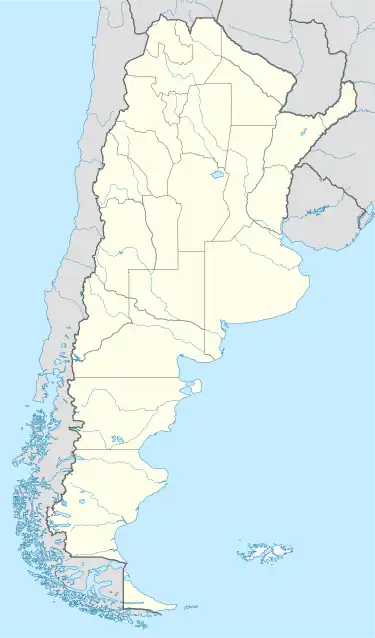Puerto Santa Cruz
Puerto Santa Cruz | |
|---|---|
Municipality and town | |
 Puerto Santa Cruz | |
|
Seal | |
 Puerto Santa Cruz Location of Puerto Santa Cruz in Argentina  Puerto Santa Cruz Puerto Santa Cruz (Argentina) | |
| Coordinates: 50°01′00″S 68°31′00″W / 50.01667°S 68.51667°W | |
| Country | |
| Province | |
| Department | Corpen Aike Department |
| Population (2010) | |
| • Total | 4,431 |
| Time zone | UTC-03:00 |
| Postal codes in Argentina | 9300 |
| Area code | 02962 |
| Climate | BSk |
Puerto Santa Cruz is a town and municipality in Santa Cruz Province in southern Argentina.[1] It lies near the Atlantic coast on the northern bank of the estuary of Santa Cruz River. It is the second oldest city in the province, being founded in 1878. It was the capital of the Santa Cruz National Territory until Río Gallegos took over the position in 1888. The town is a local centre for sheep and cattle farming. The presence of fresh water in an otherwise semi-arid environment allows for orchards and a local horticulture.
It is located at latitude 50°S and is an antipode of Prague (located at latitude 50°N).
Climate
| Climate data for Puerto Santa Cruz (1901–1960, extremes 1901–present[lower-alpha 1]) | |||||||||||||
|---|---|---|---|---|---|---|---|---|---|---|---|---|---|
| Month | Jan | Feb | Mar | Apr | May | Jun | Jul | Aug | Sep | Oct | Nov | Dec | Year |
| Record high °C (°F) | 36.5 (97.7) |
37.0 (98.6) |
32.6 (90.7) |
27.7 (81.9) |
24.4 (75.9) |
17.3 (63.1) |
17.0 (62.6) |
20.0 (68.0) |
26.7 (80.1) |
31.8 (89.2) |
32.4 (90.3) |
34.9 (94.8) |
37.0 (98.6) |
| Mean daily maximum °C (°F) | 21.1 (70.0) |
21.0 (69.8) |
18.6 (65.5) |
14.4 (57.9) |
9.1 (48.4) |
5.9 (42.6) |
5.9 (42.6) |
8.1 (46.6) |
11.8 (53.2) |
16.1 (61.0) |
18.4 (65.1) |
20.9 (69.6) |
14.3 (57.7) |
| Daily mean °C (°F) | 14.3 (57.7) |
14.1 (57.4) |
12.0 (53.6) |
8.7 (47.7) |
4.7 (40.5) |
2.0 (35.6) |
2.2 (36.0) |
3.4 (38.1) |
6.1 (43.0) |
9.2 (48.6) |
11.4 (52.5) |
13.1 (55.6) |
8.4 (47.1) |
| Mean daily minimum °C (°F) | 8.8 (47.8) |
8.3 (46.9) |
7.1 (44.8) |
3.6 (38.5) |
0.8 (33.4) |
−1.8 (28.8) |
−1.5 (29.3) |
−0.4 (31.3) |
1.2 (34.2) |
3.7 (38.7) |
6.9 (44.4) |
7.9 (46.2) |
3.7 (38.7) |
| Record low °C (°F) | −0.5 (31.1) |
−3.8 (25.2) |
−4.0 (24.8) |
−8.0 (17.6) |
−12.1 (10.2) |
−17.0 (1.4) |
−17.9 (−0.2) |
−17.0 (1.4) |
−7.4 (18.7) |
−6.6 (20.1) |
−3.4 (25.9) |
−1.8 (28.8) |
−17.9 (−0.2) |
| Average precipitation mm (inches) | 21.1 (0.83) |
12.7 (0.50) |
18.8 (0.74) |
12.5 (0.49) |
21.3 (0.84) |
14.7 (0.58) |
14.2 (0.56) |
14.0 (0.55) |
12.7 (0.50) |
10.2 (0.40) |
13.0 (0.51) |
16.6 (0.65) |
181.8 (7.16) |
| Average relative humidity (%) | 53.0 | 55.0 | 57.3 | 64.3 | 71.7 | 75.7 | 76.3 | 69.7 | 64.0 | 55.3 | 52.0 | 50.7 | 62.1 |
| Mean monthly sunshine hours | 250 | 215 | 191 | 148 | 116 | 99 | 112 | 148 | 158 | 208 | 220 | 232 | 2,095 |
| Percent possible sunshine | 51 | 54 | 50 | 47 | 42 | 41 | 42 | 48 | 45 | 49 | 48 | 46 | 47 |
| Source 1: Secretaria de Mineria,[2] Servicio Meteorológico Nacional (extremes 1961–present)[3][4] | |||||||||||||
| Source 2: FAO (sun only)[5] | |||||||||||||
Notes
- ↑ The record highs and lows are based on the Secretaria de Mineria link for the period 1901–1960 while records beyond 1961 come from the Servicio Meteorológico Nacional link since it only covers from 1961–present. When these 2 sources are used together, the record highs and lows are from the period 1901–present
References
- ↑ Ministerio del Interior (in Spanish)
- ↑ "Provincia de Santa Cruz - Clima Y Meteorologia: Datos Meteorologicos Y Pluviometicos" (in Spanish). Secretaria de Mineria de la Nacion (Argentina). Archived from the original on January 19, 2015. Retrieved April 21, 2015.
- ↑ "Clima en la Argentina: Guia Climática por localidades". Caracterización: Estadísticas de largo plazo (in Spanish). Servicio Meteorológico Nacional. Archived from the original on 7 February 2019. Retrieved 28 January 2018.
- ↑ "Fin de febrero: lo destacado del mes" (in Spanish). Servicio Meteorológico Nacional. Archived from the original on 4 March 2019. Retrieved 3 March 2019.
- ↑ "Cuadro 13: Sumas Mensuales y Anuales de las Horas de Sol Efectivas y Porcentaje de los Totales de Horas de Sol" (PDF). Estudio Sobre la Rehabilitacion de Tierras en el Valle de Viedma: Informed Final–Volumen II (in Spanish). Food and Agriculture Organization. p. 97. Retrieved July 13, 2015.
50°1′9″S 68°31′18″W / 50.01917°S 68.52167°W
This article is issued from Wikipedia. The text is licensed under Creative Commons - Attribution - Sharealike. Additional terms may apply for the media files.